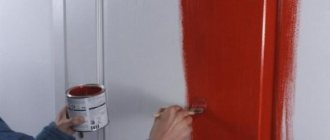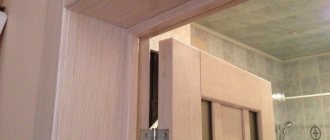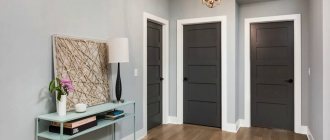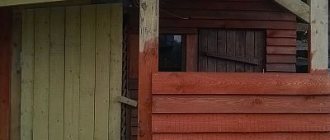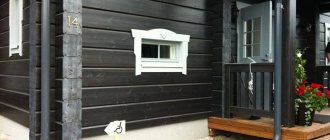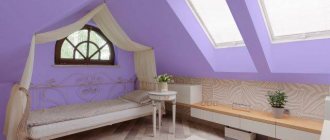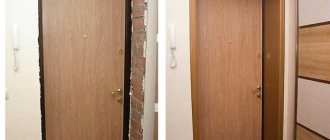Miscellaneous
The decorative covering of a door deteriorates over time and loses its attractiveness. If the old paint is cracked and peeling in places, it is recommended to remove the old coating before applying a new coat. But it also happens that the surface has only lost its shine, has become dull, or spots have appeared on it, but the layer itself lies smoothly and has retained its integrity. In such cases, there is no point in carrying out work to remove the old coating. It will not be possible to qualitatively remove the old layer of paint that has retained its strength. It is difficult to remove. As a result, you can only damage the doors or get a surface whose quality is much lower than the original version.
Features of painting over an old layer
At first glance, painting a wooden door over an old layer seems like a trivial matter: just go ahead and paint it.
Painting the door
But in fact, in order to paint a wooden door and get a surface that will be no worse in quality than factory painting, learn a few rules:
- The surface of the door, regardless of its condition, must be carefully prepared. Against the background of the old paint, cracks and potholes are invisible, but after applying a new layer they will appear and ruin all your efforts.
- The right choice of material for painting an interior door. It’s not just a matter of proper selection of color, surface texture or the strength of the film formed. It is important to consider the compatibility of materials. Many paints are not compatible with each other, and if chosen incorrectly, the old coating may curl or bulge when it comes into contact with the new material.
- Decide on the correct paint application technique. For doors with a complex structure, it is possible to obtain a smooth and neat surface with proper selection and combination of painting techniques and painting tools.
The last rule, common to all cases of working with paint, is to strictly follow the instructions for applying the selected paint material.
How to imitate wood
If you need to paint the door leaf to look like wood, there is a simple solution for this. At the same time, wood patterns can be easily created on any type of surface.
At the preparatory stage, all work is carried out in the same way as with ordinary painting. And then, take two types of flowers. Color can vary over fairly wide ranges. It is recommended to use any suitable color: from light beige to brown.
So, several layers of the main color are applied to the surface. When the paint has dried, you can begin to apply a second, auxiliary color. It is better to apply the second paint in as thin a layer as possible. In this case, you don’t have to wait for everything to dry. Remove some of the paint with a special grater.
The grater must be worked with combing movements in the longitudinal plane. As a result, the surface will have an imitation of wood fiber. To give the surface shine, the already dried layers are additionally coated with a special varnish.
Practicality for doors
To protect the paintwork, the surface is coated with a special varnish. It is easy to apply, has an aesthetic appearance and is quite durable. Using this varnish you can significantly increase the service life of the product, protect the door from moisture and other destructive factors.
As you can see, the painting process does not involve any complex technologies. All this can be done at home with your own hands. It is only important to choose the right paint and varnish materials. Then you can guarantee high surface quality.
Which paint to choose
First, decide what paints are used to apply to the door:
- Alkyd enamels. This is the most affordable option. Film strength is average. The advantages include a large range of colors and compatibility with MDF, fiberboard and wood. The main disadvantage is the long drying time and the characteristic pungent odor. Among materials of this type there are a large number of glossy coatings.
- Acrylic enamels. This type of paint is a water dispersion of acrylates. The main advantage over other compositions is the absence of odor and quick drying. In addition, the color palette, represented by hundreds of colors, allows you to create unique shades yourself. To protect the surface, it is additionally coated with parquet transparent varnish.
- Oil-based tinting paints are great for transforming interior and entrance doors. Absorbing into the wood texture they give it a unique shade. The only condition for their use is wood, without any coating.
Variety of paints and varnishes
- Nitro enamels. They dry quickly, but at the same time the volatile, caustic solvent evaporates, which can cause poor health and even poisoning. If you take precautions and use personal protective equipment when working, then this option deserves attention. After the solvent has completely evaporated, the coating becomes safe. It is considered a high-quality and fast method of painting.
- Colored varnishes, glazes. These materials are used for painting varnished door panels. Used in cases where there are no significant cracks or chips on the base. To fully restore the varnished surface, the old varnish must be removed, or you can refuse to re-varnish and paint over the interior doors after puttying.
How to paint a wooden door?
The paint for the door leaf must meet high performance characteristics and be safe for human health. Conventionally, paint and varnish materials are divided into two groups:
It is better to paint new wooden interior or entrance doors with transparent varnishes and impregnations. The applied layer is a decorative glaze that does not hide surface defects. A transparent coating can highlight the interesting structure of new wood.
Opaque paints or enamels for windows and doors are made from solvents with added pigments. Under a new layer it is easy to hide wood defects, uncleaned areas of old paint, or simply give the door block a new original look.
Most often, when restoring a wooden door, preference is given to opaque paints.
From a wide variety of interior work, it is best to choose safe water-based paint or varnish. From the street, a wooden canvas can even be coated with nitro paint.
Alkyd paint
It is advisable to use alkyd paint during major renovations when no one lives in the apartment. During this period, all toxic odors will have time to disappear. The dried surface can be matte or glossy, but in any case it repels moisture well.
Alkyd quick-drying enamel is characterized by the presence of a pungent odor. Its popularity is justified by the variety of colors, low cost, and resistance to aggressive environmental influences.
Alkyd varnish
Due to their transparent structure, it is better to cover a new wooden interior or entrance door. The disadvantage is the strong odor and long drying time. A shiny transparent glaze will highlight the beauty of natural wood.
Acrylic paint
The best choice to paint interior wooden doors indoors. The advantage of the coloring composition is the absence of a toxic odor, as well as the ability to preserve the wood texture. A thin layer allows the wood to “breathe”.
Acrylic enamels dry quickly, and after painting there is no toxic odor indoors. Another advantage is the large selection of colors. The disadvantage is the high cost. After drying, the surface becomes matte. Additional opening with acrylic varnish further increases the cost of painting a wooden structure.
Acrylic lacquer
Acrylic varnish is perfect for covering a new, unfinished interior door. The non-flammable composition, harmless to human health, will preserve the color and texture of the wood. The wooden door leaf on the street side is not coated with acrylic varnish.
Thermal enamel
It is unreasonable to use it for an interior door block. The paint is expensive and its main purpose is to protect the painted surface from low and high temperatures. If desired, you can paint a wooden or metal door at the entrance to the house. Thermal enamels differ in their scope of application. For wooden panels, Bosny aerosol paint is suitable, which can withstand, depending on the brand, heating up to a temperature of +200°C or +650°C.
Nitropaint
The most durable and durable paint for wooden doors is nitro varnish or nitro enamel, but it is better not to use it for interior door blocks. They are highly toxic and can only be handled in well-ventilated areas. Nitro paint is suitable for the front door. If it needs to be removed in the future, it will not be easy to do.
Polyurethane paint
Polyurethane paints, characterized by good adhesion to wood, are gaining popularity. With proper preparation of the wooden surface, you can not be afraid of the appearance of blisters on the door. The dried layer of paint is completely harmless to humans, retains its bright color over a long period of use, and is also resistant to scratches. The main advantage of the polyurethane layer is elasticity. If the wood is slightly deformed, cracks will not appear in the paint.
Material Compatibility
It is not so easy to understand the modern variety of materials. Chemical compositions for the uninitiated person are a secret behind seven locks, and when buying a material to apply to old paint, many rely on luck, hoping that the old layer will not react in any way to contact with the new chemical. There are some recommendations according to which you should select the material depending on what the door is painted with.
Variety of colors
Therefore, before you go for paint, you need to clarify what the canvas is painted with.
- Epoxy and polyurethane compounds contain aggressive solvents. Cyclohexanone or xylene are capable of destroying materials that are reversible polymers obtained by natural curing (nitrocellulose, vinyl, copolymer-vinyl chloride compounds). Simply put, epoxy or polyurethane paint will destroy the coating made with nitro paints.
- Epoxy and polyurethane materials are applied only over the same compositions or primers, maintaining drying intervals for each layer.
- Silicate compounds are generally not applied over any other types of paints.
- Alkyd paints are not aggressive and can be safely applied over any material.
- Copolymer-vinyl chloride compounds and compounds based on chlorine rubber are applied only over acrylic, epoxy, and silicate materials.
Important! To update the door, it is better to use paint of the same type as the previous layer.
Compatibility table
Despite the recommendations of the material compatibility table, it is better to use an experimental test: apply the new material to a small area of the canvas and see the reaction.
Features of working with different surfaces
If the old door looks good, but the coating has only faded and worn out, then it can be quickly updated by such an event as painting the door without removing the previous layer. The tactics of work will depend on the type of coating available:
Painted doors
This option will cause the least amount of trouble with preparation and has every chance of getting a high-quality surface. To paint interior doors with your own hands, just thoroughly wash the surface of the door to remove dirt and grease stains, and fill all cracks and gaps with putty. It is better to take automotive epoxy paints with a hardener. Such putties do not shrink when dry, and all defects can be repaired in one go.
After the putty has dried, the surface is sanded with fine (120 grit) sandpaper. It is better to use a vibrating sander on large flat surfaces (counters, panels). The main task when working with a painted door is high-quality painting, which is achieved by applying several uniform layers of material. The duration of the work will directly depend on the time it takes for the next painted layer of the door to completely dry.
Old painted door
Lacquered doors
If you decide to renew the varnish surface by applying a new layer, it should be taken into account that all defects will remain visible.
Important! Secondary varnishing rarely gives the expected results. As a rule, the surface should be close to ideal. If you don’t want to tinker with the old coating, then it’s better to paint varnished interior doors that have lost their appearance or coat them with a tinted glaze.
The main difficulty in this situation is selecting putty to match the base material. But the wooden surface is not monochromatic in nature. Even if you spend a lot of time and use several shades of putty, you will still end up with stains on the canvas.
How to paint a lacquered door to transform it
It often happens that you are quite tired of varnished doors, but there is no money to purchase new ones. You can find a way out of this situation, transform the door so that it pleases not only you, but your entire family. But in order to do this correctly, you need to know the technology of preparatory work and the process itself, how to paint a varnished door. In this article we will tell you how to reproduce all these works.
We prepare tools and materials before painting
•Liquid for degreasing.
•Spatula, screwdriver, brush, roller or spray gun.
Preparing the door surface for painting
In order for the paint to adhere well to the surface of the varnished door, it must be pre-treated before painting. Therefore, before painting a varnished door, it should be prepared for this process. You should not skip the preparatory work, since 80% of the successful finishing of the door as a whole will depend on them.
Surface preparation process
•We prepare the place where painting will be carried out. This process can take place on site, then paper or oilcloth is placed under the doors. If you decide to remove the door from its hinges, then prepare a special table on which the doors will be painted.
•All locks, handles and decorative elements are removed, and the surface of the door is degreased with an alcohol or vinegar solution.
•Using a hair dryer, remove the varnish coating from the heated surface of the door with a spatula. This process is carried out until the paint layer is completely removed.
•All surface irregularities and old coating are sanded with sandpaper to a smooth, rough state.
•If there is such a need, then the surface of the door is coated with an antiseptic.
•If there are defects, cracks and chips on the surface of the door, they should be removed using wood putty. The best option for this would be a fine-grained composition that dries quickly.
•After drying, the areas treated with putty must be sanded.
•Then the door leaf is primed in two approaches. After the first layer has dried, the second is applied.
Painting a lacquered door
Now we come to the climax of our article, where we will learn how to paint a lacquered door. The work should begin with painting all the recesses and door edging
You shouldn’t put a lot of paint on the roller to avoid smudges, and if they do happen, you should remove them as quickly as possible before the paint dries. If after the first layer, the door leaf is not uniform and there are bald spots, then you need to apply a second layer of paint.
Painting an old door that has already been painted
It also happens that you have to restore a fairly old door leaf that has already been painted. Here you will have to work a little more. Now we will tell you how to paint a varnished door if it has already been painted previously.
•Locks and handles are removed from the door.
•The door surface is thoroughly washed and dried naturally.
•The door leaf is processed with sandpaper.
•The areas that are not to be painted are sealed with masking tape.
•The surface of the door is treated with a thin layer of primer. You should not apply a lot of impregnation, since it will not be absorbed into an already painted surface, but will stand out as separate puddles on the surface of the door or smudges if the doors are painted in a suspended state.
•After this we proceed to applying the main paint. This should be done after the primer has completely dried. The coating layer should be as thin as possible; it is better to have two or three thin ones than one thick one. Just keep in mind that before applying a fresh coat of paint, the previous one must dry.
Door painting technologies
The quality of the door coating depends on the tool, application method and professional skills of the craftsman.
Tools
Door painting is done using the following tools:
- Brushes. It is not recommended to paint the entire canvas with just one brush. If you lack experience, the surface will end up with streaks. It will not be possible to apply a thin, even layer of paint with a brush. But without this tool it will not be possible to paint hard-to-reach places, corners, layout patterns or panel margins. Therefore, when painting canvases with a complex configuration, first work with a brush, painting over problem areas.
- Roller. Repainting panel interior doors is done with just a roller. The roller bobbin must be fur, polyamide or polyacrylic. These materials are resistant to most aggressive solvents.
Important! For painting work on door restoration, foam rollers are not used.
Working with a brush
- Compressor (spray gun). A spray bottle will allow you to get an even, thin layer. The result is a perfectly smooth coating. The process of applying paint is much faster than manually.
Related tools you can’t do without:
- gloves;
- paint tray;
- rags;
- masking tape;
- sandpaper;
- putty knife;
- and what you have at your disposal: stools on which you will place the canvas, or sawhorses.
In addition to paint and varnish, prepare putty, primer and solvent.
Types of paints for doors
Don't be intimidated by the huge variety of coloring enamels. The packaging always contains detailed instructions for using a particular coating.
And the first thing you need to pay attention to is what material the paint is intended for. Improper use leads to rapid wear of the door coating - loss of shine, peeling and cracking. There are four types of coatings for wooden products:
There are four types of coatings for wooden products:
- Alkyd enamels and varnishes are pleasing with their prices and wide color palette. The polymerization process takes place quickly - after 1.5 - 2 hours, the painted surface sets and is resistant to the influence of dust, humidity and deformation. Complete drying occurs within 24 hours. To treat a wooden surface, you can use a brush or roller. The disadvantages include:
- fragility, after 1–2 years the surface loses its luster, burns out, and cracks when temperature changes;
- the presence of toxic substances that are not recommended for use indoors. The door emits a specific odor for a long time;
- exposure to temperature changes. Alkyd resins, on the basis of which enamel is produced, tolerate high humidity well, but changes in temperature conditions lead to cracking of the smooth surface. The optimal range is -30°… +5°С.
- Acrylic enamels and varnishes. Manufactured on a water basis. The disadvantages of alkyd paint and nitro enamels are mitigated due to the composition selected from water-soluble colors. The only disadvantage of acrylic material is its high price. The undoubted advantages are:
- absence of harmful substances and volatile solvents in the composition;
- wide range of colors;
- the formation of an elastic elastic film upon drying, on which cracks do not form;
- color stability to ultraviolet radiation.
- Nitro paints and varnishes. They are used outside residential premises, most often in industrial facilities. This is due to the fact that the solvent on which the paint is made is toxic and flammable. When carrying out work, it is necessary to ensure good ventilation of the room. Nevertheless, this type of coating is in demand because it is the most durable and resistant to adverse factors. Drying occurs within 30–60 minutes (depending on the thickness of the layer). The polymer film covering the wood lasts up to 5 years without compromising its appearance.
- Oil paints. Absorbs into wood by 0.3–0.5 mm (depending on the type of wood). Thanks to this, the outer surface layer becomes water-repellent and durable. However, today this material is not so popular, and there are good reasons for this:
- long drying time - complete hardening occurs no earlier than after 24 hours (depending on environmental humidity);
- low compatibility with other types of paints. If it is necessary to re-coat the doors, the previous layer must be completely removed (including sandpaper treatment);
- high price;
- sensitivity to mechanical damage.
All types of paints described are used for metal doors, but there are also those specially designed for steel surfaces. These include:
- Hammer paint. The coating combines good decorative properties with increased durability. After drying, a pattern appears on the doors, simulating the impact of a forge press. Operational advantage - the paint can be applied to a rusty surface, having previously degreased and removed small debris and dust. There are other advantages:
- high durability of the coating, which can withstand even impacts from metal objects;
- long service life, it exceeds 10–12 years;
- protection of metal from corrosion, temperature and humidity changes.
- Powder paint. Industrial version of door painting. It is impossible to apply the coating at home, since this requires special equipment - a muffle furnace in which the powder is melted and baked. The result is an extremely durable coating that lasts for several decades.
- Forge paint. An expensive coating that can turn an ordinary door into a work of art. Various colors and shades allow you to imitate gold leaf or silver that has become tarnished over time. In such cases, specialist artists are most often invited, who are guaranteed to give the coating the necessary visual effect. Performance properties are as high as those of hammer paint. Long service life and resistance to adverse factors compensate for financial costs.
Painting schemes
First, a little theory. The interior door can be panel or panel. Depending on this, the execution scheme and the order of staining will depend.
If it is a panel-type canvas, then painting is carried out in 3 stages:
- Coloring begins from the upper corner in the transverse direction. The movement of the brush goes from left to right.
- the second layer of paint is applied in the longitudinal direction.
- the third layer is similar to the first.
Please note that three layers cannot be applied at once; after each coating, time must pass for the composition to dry.
For work, it is better to use a roller, as the brush may leave streaks.
If it is a paneled door, then first all the recesses are painted with a brush, and then the rest of the panel, but with a roller.
Stages of work
All work can be written in the form of the following algorithm:
- It is better to remove the door and twist the fittings. If there is no such possibility (or desire), then handles, hinges, locks and glass are sealed with film and masking tape. It will be difficult to remove the paint. The tape must be removed before the paint dries.
- Washing and drying the door surface.
- Removing peeling areas, filling defects, sanding. Each layer is sanded after complete drying.
- Selecting the type of paint material.
- Applying a primer (paint diluted with the same type of solvent). This will improve adhesion and reduce the likelihood of bleed through putty areas.
- Applying the required number of layers of paint or varnish.
DIY door painting
Before you start painting the doors, you need to carry out the preparatory stage of work. First you need to decide what means will be used to apply the coating.
Painting methods:
- using brushes;
- roller;
- spray bottle.
Then you need to prepare the tools and materials,
- Preparation of the necessary material: prepare paint, solvent, brushes (or roller, spray gun).
Cover the surface around the perimeter of the doors that will not be painted with masking tape. Place a protective film on the floor. Prepare a rag so that you can wipe off paint if it gets on your clothes, hands, or smudges. It is better to work with gloves. If you use nitro enamel or alkyd paints, you must wear a gauze mask.
- Preparing the door.
To paint a metal door with your own hands, you need to clean the door leaf from the old coating.
The process of removing old paint from a wooden door
To do this, use metal brushes, grinder attachments, abrasive meshes, and sandpaper. It is necessary to remove any remaining paint and remove rust. The old layer is especially carefully removed if the canvas was previously painted with a color different from the new paint.
- Surface primer.
Before painting the doors, the prepared surface is impregnated with an anti-rust agent. After the canvas has dried, cover it with a layer of primer. It is best to use compounds from the same company as the main paint coating. The primer will ensure deeper penetration of the enamel into the surface layer of the metal and improve adhesion to the door leaf.
- Coloring rules.
Depending on the method in which the paint will be applied, its consumption varies. The least amount of paint is used per 1 square meter when using a spray gun. Paint and varnish compositions are diluted according to the instructions, using exactly those solvents that are indicated in it or those that are similar in composition. For a brush or roller, the paint should be so thick that it does not run off. Ready-made formulations must be mixed thoroughly before use. It is recommended to use fine-pile rollers.
Please note that paints and varnishes for a spray gun should have a more liquid composition compared to those applied with a roller and brush. Read the instructions carefully; manufacturers provide detailed information about the proportions and solvents used.
Applying a second coat of paint on a metal door
The paint is applied in several layers, each previous one must first dry. The peculiarity of painting work is that if the surface is painted with a brush or roller, the layer is applied first in the horizontal, then in the vertical direction. Paint 2-3 times. In this way the layers of paint are leveled.
Applying paint to a door with a brush
The spray paint should be applied in such a way that it lays down in an even thin layer and does not form smudges. To do this, you need to choose the right spray distance. The same rule applies to paint packaged in spray cans.
Spray painting a metal door
Shake it for 15 minutes before use. Manufacturers' recommendations indicate the optimal pressure in the spray gun; for example, for hammer paint it is 6 atmospheres. Watch the video for detailed instructions on painting a metal door.
Metal door painting option
The ingredients included in the composition suppress the development of the metal rusting process. The modern market of paint and varnish products offers a wide range of effective products that will transform a metal door and ensure their reliable protection.
Useful tips for beginners
For ease of work and control over dipping the tool into paint, use a paint tray.
After purchasing the brushes, it is recommended to comb them out a little and soak them in water for a while. Firstly, this will prevent fallen hairs from reaching the surface, and secondly, it will soften the stubble before work.
It is more convenient to paint the canvas if it is located in a horizontal position. This way you won’t get unsightly streaks if there is too much paint in the corners and sides of the door leaf. Many people use specially prepared sawhorses for convenience, or take the easier route and place the door on 4 stools.
Protection of fittings from smudging. This is not a whim, but a reasonable step. It is advisable to twist it and put it aside for the duration of the work, but an option to protect it is also suitable, for which it is recommended to use masking tape.
Drips resulting from painting can be easily removed if you use a sponge, and then hide its traces by going over the area with a roller.
While the painted canvas is drying, make sure that no accidental dust gets on it or that a stray midge does not stick to it. To do this, it is better to do coloring in a special workshop.
Video on how to properly paint entrance blocks in a house or apartment:
You can update interior or entrance doors in different ways. Painting without removing the old layer is the easiest and fastest method, which home craftsmen most often resort to. The result of the work: a beautiful door without much effort!
Voted over 169 times, average rating 4.6
Comments
Ira 01/30/202015:56 It’s better not to paint interior doors. the paint will stink for a long time
Grade
Add a comment Cancel reply
We recommend reading
Miscellaneous Interesting glass decoupage technique, DIY door decoration Do you want to update the decor of your favorite room, but don’t want to start again...
Miscellaneous Recommendations from professionals on choosing a door frame for interior doors To install a door, you will need to choose the right door…
Miscellaneous Main distinctive characteristics of moldings for interior doors Manufacturers offer door designs of standard sizes, ...
Miscellaneous What is the purpose of installing brushes on interior doors? To make using the interior door convenient and not separate...
Color selection
Choosing the color of the door will help it become a bright accent of the room or, on the contrary, merge with the interior. It is important to achieve harmony with the overall appearance of the apartment. The shade of the canvas should be consistent with the furniture and wall decoration:
- For an interior in warm colors with wooden furniture and parquet, doors made of solid wood or imitation natural wood are suitable.
- For rooms in cool colors - plain, plain-colored options.
- A white door will fit perfectly into any room, as this color goes well with any others. This statement is true if the color of the door matches the shade of the ceiling trim and the color of the window frames.
- If the room has linoleum or carpet, the door leaf should be combined with the floor covering.
- You can create a successful ensemble by painting the door block in colors that match the textiles on the windows or furniture upholstery.
- A dark door leaf will become a contrasting element of an interior decorated in light colors.
- For bedrooms and children's rooms, pastel shades are recommended when painting. The color of the doors should be different from the wallpaper, darker or lighter.
- If there are antiques in the house, the ideal solution would be a door painted “antique” with a patina effect.
Patina can be applied with the following compositions:
- acrylic - the richest range of colors;
- bituminous, giving a dark brown tint;
- wax, made in natural colors - brown or bluish-green;
- shellac - a palette ranging from gold to red.
